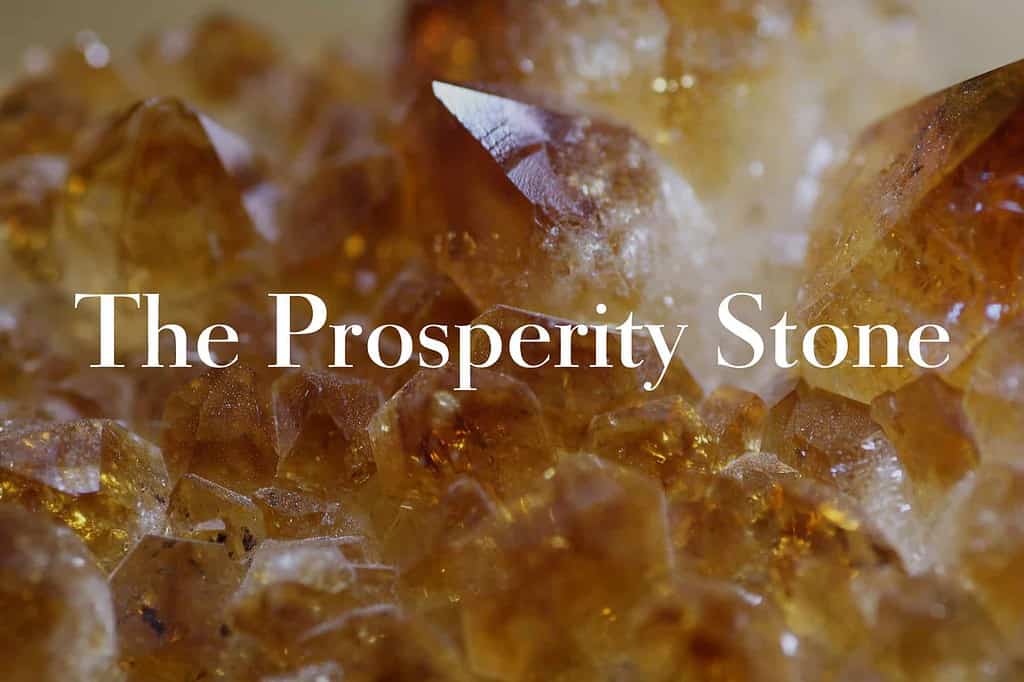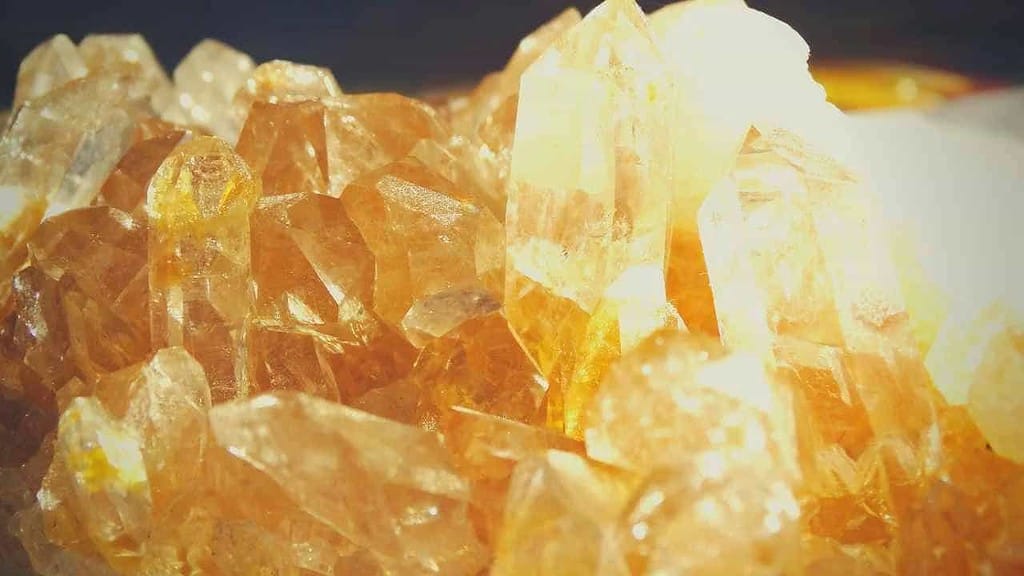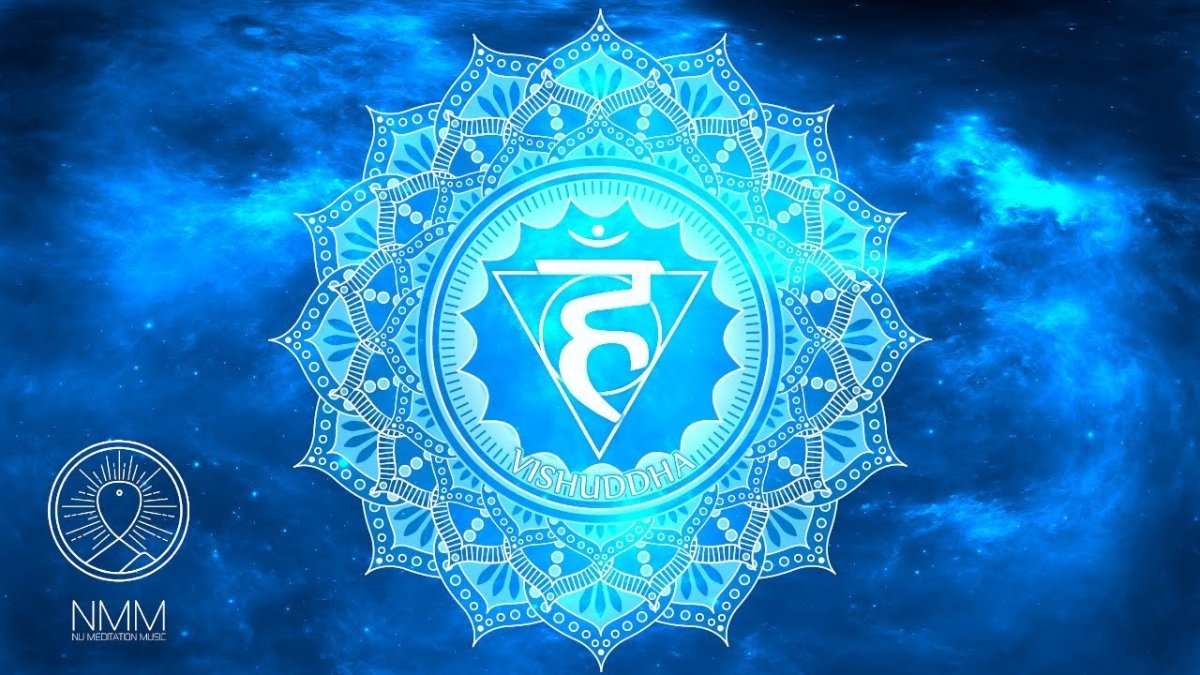Citrine Crystal Secrets – Its Meaning, properties and benefits
The post Citrine Crystal Secrets – Its Meaning, properties and benefits appeared first on The Yoga Nomads.

Today, let’s journey into the fascinating world of Citrine – the ‘Light Maker.’ This beautiful gemstone possesses a radiant glow that is reminiscent of the sun and has an energy that can brighten even the darkest corners of life. For centuries, Citrine has been a symbol of wealth, wellness, and wisdom, capturing our imaginations and adorning our bodies.
But what secrets does this luminous crystal hold within its warm embrace? Whether you’re an experienced gem enthusiast or new to the world of crystals, you’re in the right place to uncover the mysteries of Citrine.
This comprehensive guide will take you through the meaning, properties, and benefits of Citrine, exploring its potential for healing, its connection with our zodiac signs and chakras, and much more. You will also learn how to cleanse and maintain your Citrine gemstone, ensuring its radiance remains untarnished for generations.
What is Citrine?

Origin of the Name and Appearance
Citrine, famed for its stunning shades of golden yellow, gets its name from the French word “citron,” meaning lemon – a fitting homage to its citrus-like hue. This striking member of the quartz family has a vast spectrum of colors, ranging from the palest yellow to deep, burnt orange.
Natural Vs. Commercial Citrine
Natural Citrine is quite a rare gem. Interestingly, most commercial Citrine available today is actually heat-treated amethyst or smoky quartz. High temperatures transform the colors of these stones into the yellow and reddish-orange shades characteristic of Citrine.
Global Occurrence
Although Citrine can be found in several places worldwide, Brazil is the leading producer of this gemstone. Other notable sources include Russia, Madagascar, and the United States, particularly in Colorado, North Carolina, and California.
Citrine and the Quartz Family
Citrine, as part of the quartz family, shares its lineage with other popular gemstones like amethyst, rose quartz, and agate. Quartz, a silicon dioxide mineral, boasts a wide range of colors and varieties. With a Mohs hardness of 7, Citrine’s durability makes it an ideal choice for a variety of jewelry applications.
Symbolism and Cultural Significance
Known historically as the “Merchant’s Stone,” Citrine has long symbolized wealth and abundance. This gemstone’s allure transcends its physical beauty, as it has often been used as a decorative gem and amulet believed to attract prosperity and success.
Citrine in Mythology and Popular Culture
Citrine’s rich history extends into mythology and popular culture. Ancient societies believed it offered protection against snake venom and evil thoughts. In the context of Chinese feng shui, Citrine is considered a magnet for prosperity, particularly beneficial for achieving business success.
Modern Uses of Citrine
In contemporary times, Citrine remains a favored choice for jewelry. Beyond its aesthetic appeal, it is also valued as a tool for meditation and healing rituals. Its purported properties to cleanse, energize, and revitalize make it a sought-after crystal in these practices.
In the sections that follow, we’ll delve deeper into the healing properties, uses, and benefits of Citrine, and its association with zodiac signs and chakras. As we peel back the layers of this intriguing crystal, you’ll discover the captivating potential that Citrine has to offer.
Citrine’s Healing Properties

Citrine’s radiant hues are not just visually uplifting; they are believed to offer an array of healing benefits on physical, emotional, and spiritual levels. Here, we explore these facets in depth.
Physical Healing Properties
Citrine, in the realm of crystal healing, is thought to offer various physical health benefits. Its energy is said to support the endocrine system and encourage proper metabolism. It’s also often associated with improving issues related to digestion and weight loss.
Some people believe that Citrine’s warm, sun-like energy can rejuvenate the body, enhance physical stamina, and support the circulatory system. Additionally, the crystal is often turned to for its alleged abilities to stimulate tissue regeneration and bolster the immune system.
Emotional and Mental Healing Properties
When it comes to emotional and mental health, Citrine is considered a powerful ally. Often referred to as a joyful stone, it is thought to carry the power of the sun, which can help dispel negativity, fears, and phobias. Its vibrant energy is believed to stir optimism and creativity and encourage clarity of thought.
Citrine is also considered a stone of manifestation. Its positive energy is said to promote personal will, mental focus, and the courage required to transform dreams and wishes into tangible form. By promoting a positive mental state, it’s believed to assist in overcoming depression, reducing self-destructive tendencies, and enhancing self-esteem.
Spiritual Healing Properties
Spiritually, Citrine’s energy is linked to higher consciousness. As a manifestation stone, it’s said to not only attract wealth and prosperity but also help you achieve your spiritual goals. It’s believed to enhance concentration and revitalization, which can lead to a more profound spiritual understanding and growth.
Citrine is also considered a powerful cleanser and regenerator that carries the power of the sun. This makes it an exceedingly beneficial stone for spiritual and intuitive growth. Its warm energy is believed to promote inner calm so wisdom can emerge, making it a popular choice for meditation practices.
Citrine’s variety of healing properties, from physical vitality to mental clarity and spiritual growth, make it a well-rounded healing stone. As we continue to explore its benefits, uses, and connections to zodiac signs and chakras, Citrine’s potential will become even more evident.
How to Use Citrine

Citrine’s vibrant energy and diverse healing properties make it a versatile tool. It can be utilized in a multitude of ways, ranging from meditation and spirituality to crystal healing, jewelry, decoration, Feng Shui, and manifestation work. Let’s explore these in more detail.
Use in Meditation and Spirituality
One of the most common ways to use Citrine is in meditation. Its warm, radiant energy can help create a calm, focused state of mind. Hold a piece of Citrine in your hand, or place it nearby while meditating to inspire clarity of thought and a deeper spiritual understanding.
Use in Crystal Healing
In crystal healing, Citrine is often used to aid in physical, emotional, and spiritual wellness. Place it on the part of the body where healing is needed, or use it to align and cleanse your chakras, particularly the Solar Plexus and Sacral Chakras.
Use in Jewelry and Decoration
Citrine’s sunny hue and durable nature make it a popular choice for jewelry. Wearing Citrine can help you carry its positive energy throughout the day. Whether in a pendant, bracelet, or earrings, Citrine jewelry can help manifest success, abundance, and positivity. As a decorative element in homes or offices, Citrine can imbue your space with vibrant energy and attract wealth and prosperity.
Use in Feng Shui

Citrine is widely used in Feng Shui, a Chinese philosophical system of harmonizing with the surrounding environment. Often known as the “Merchant’s Stone,” it’s frequently placed in cash boxes or wealth corners of the home to attract abundance. Its sunny energy also brings a sense of warmth and comfort to any living space.
Use in Manifestation and Abundance Work
Citrine is known as a powerful manifestation stone. Write down your wishes or goals, and place the paper under a Citrine crystal to charge it with positive energy and intention. It’s believed that Citrine can help manifest your intentions into reality by attracting the energies of success, abundance, and personal will.
Learning how to use Citrine allows you to tap into its full potential. Whether for healing, self-improvement, or bringing about positive changes in your life, Citrine can be a precious and powerful tool in your spiritual toolbox. In the upcoming sections, we’ll dive deeper into Citrine’s benefits, its zodiac connections, associated chakras, and more.
Citrine’s Main Benefits

The golden hues of Citrine are not just beautiful to behold, but they also carry a wealth of benefits. From promoting health and wellness to instilling emotional balance, driving spiritual growth, and manifesting wealth and prosperity, Citrine truly stands as a gem of many virtues.
Benefits in Health and Wellness
Citrine is believed to offer a plethora of health benefits. As a potent healing crystal, it’s thought to support the endocrine system, bolster the metabolism, and stimulate tissue regeneration. It’s also used to rejuvenate the physical body, enhancing stamina and supporting the circulatory system. By promoting physical well-being, Citrine contributes to overall health and wellness.
Benefits in Emotional Balance
As a joyful stone, Citrine is often turned to for emotional healing. Its sunny and vibrant energy is believed to dissipate negativity, instilling happiness and optimism in its stead. Citrine also promotes self-esteem and self-confidence, and it encourages the expression of individuality, thus creating a balance of emotions and leading to personal contentment.
Benefits in Spiritual Growth
Citrine is often associated with spiritual growth due to its ability to clear the mind and stir the soul. Its energetic properties can enhance concentration and promote inner calm, enabling wisdom to emerge. This can lead to a profound spiritual understanding and growth, making Citrine a favorite amongst those pursuing a spiritual journey.
Benefits in Wealth and Prosperity
Perhaps one of Citrine’s most recognized attributes is its ability to attract wealth and prosperity. Often dubbed the “Merchant’s Stone”, it’s believed to manifest success and abundance in business. Its potent energy can stimulate a mindset of positivity and hard work, leading to material prosperity.
Citrine, with its manifold benefits, serves as a beacon of positivity, health, emotional balance, spiritual growth, and wealth. As we continue to uncover the many layers of this sunny gemstone in the following sections, its deep connection with zodiac signs, chakras, and other areas will illuminate even further.
Citrine Zodiac Birthstone

While crystals and gemstones can be enjoyed by everyone, certain stones are believed to resonate more powerfully with specific zodiac signs. In the case of Citrine, it’s particularly associated with the signs of Gemini, Aries, Libra, and Leo.
Gemini (May 21 – June 20)
As a Gemini birthstone, Citrine is said to enhance the dual nature of Geminis by balancing their yin and yang energies. It’s believed to promote clarity of thought, aid concentration, and stimulate the memory – essential traits for the intellectually oriented Gemini.
Aries (March 21 – April 19)
Citrine resonates well with the energetic and fearless Aries. The stone’s vibrancy is believed to amplify the natural enthusiasm and leadership qualities of this sign. Moreover, it is thought to encourage Aries’ naturally optimistic and brave spirit.
Libra (September 23 – October 22)
For Libras, a sign often needing balance in life, Citrine can serve as an energetic support system. It’s believed to help Libras find equilibrium between their intellectual and emotional sides. Furthermore, Citrine’s joyful energy might help Libras maintain their inherent positivity and need for harmony.
Leo (July 23 – August 22)
Finally, Citrine is often associated with Leo, the sign ruled by the sun. The stone’s sunny and warm energy complements Leo’s naturally cheerful and generous nature. It’s believed to enhance their creativity, confidence, and overall zest for life.
Regardless of your zodiac sign, if you feel a natural pull towards Citrine, don’t hesitate to use it. The gem’s radiant energy, healing properties, and numerous benefits can enhance anyone’s life, bringing a slice of sunshine to all who embrace it. We’ll continue to explore Citrine’s fascinating facets in the upcoming sections.
Citrine’s Associated Chakras

Chakras are energy centers within the human body, each associated with different physical, spiritual, and emotional functions. Citrine, with its radiant energy, is closely associated with two primary chakras: the Sacral Chakra and the Solar Plexus Chakra.
Sacral Chakra
Located just below the navel, the Sacral Chakra, also known as Svadhisthana, is linked with creativity, sexuality, and emotional balance. Citrine’s vibrant and warm energy is believed to stimulate this chakra, promoting emotional harmony, enhancing creativity, and encouraging self-expression. A balanced Sacral Chakra allows for the free flow of emotions and the ability to connect with others.
Solar Plexus Chakra
The Solar Plexus Chakra, or Manipura, located in the stomach area, is the center of personal power, confidence, and identity. Citrine is particularly effective in stimulating this chakra due to its association with warmth, clarity, and manifesting willpower. When this chakra is balanced, it can cultivate a sense of personal power and self-confidence, making you feel motivated and in control of your life.
Using Citrine to balance these chakras can help to promote emotional well-being, enhance creativity, encourage personal growth, and nurture self-confidence. These traits align well with the commonly recognized benefits of Citrine, highlighting its holistic influence on human energy systems.
In the upcoming sections, we’ll look at how to cleanse your Citrine gemstone, its geological properties, its history, and more, to ensure you have a comprehensive understanding of this stunning crystal.
How to Cleanse Your Citrine Gemstone
Just like any other crystal, Citrine needs to be cleansed regularly to maintain its vibrant energy and healing properties. Here are some of the most effective ways to cleanse and recharge your Citrine gemstone.
Sunlight or Moonlight Bath
Citrine, carrying the power of the sun, can be effectively cleansed by bathing it in sunlight for a few hours. Be mindful not to leave it out for too long, as prolonged exposure can cause the color to fade. Similarly, you can leave your Citrine under the moonlight, especially during a full moon, to recharge its energy.
Smoke Cleansing
Smoke cleansing is another popular method for purifying your Citrine. You can use sacred herbs or incense such as sage, Palo Santo, or sandalwood. Pass your Citrine through the smoke several times with the intention of cleansing the stone of any negative or stagnant energy.
Sound Healing
The vibrational energy from singing bowls, tuning forks, or even bells can also cleanse Citrine. Play the instrument near your Citrine with the intention of clearing and recharging the stone. The sound waves will penetrate the crystal and drive away any negative energy.
Other Crystals
Certain crystals, like Selenite and Clear Quartz, are known for their cleansing properties. You can place your Citrine on a Selenite slab or beside a Clear Quartz overnight to cleanse and recharge it.
Visualization
Another powerful way to cleanse your Citrine is through visualization. Hold your Citrine and imagine a bright white light surrounding the stone, removing any negativity and recharging its energy.
Remember, regular cleansing is vital to keep your Citrine vibrant and potent. Now that your Citrine is cleansed and recharged, it’s ready to be used again. In the following sections, we’ll delve into the geological properties of Citrine and uncover its fascinating history.
Citrine Geological Properties

Citrine’s captivating beauty is a result of its unique geological formation and properties. Let’s delve into its origins, mineral composition, and more.
Origins and Formation
Citrine is a variety of quartz, one of the most common minerals on Earth, which forms within igneous, metamorphic, and sedimentary rocks. The stone gets its distinctive yellow color from iron impurities within the quartz structure. The range of colors – from pale yellow to honey, from golden to brownish-red – depends on the quantity and valence state of the iron impurities.
Natural Citrine is relatively rare. Most commercial Citrine is heat-treated amethyst or smoky quartz, where the high temperatures change the iron impurities causing the color change.
Physical Properties
Citrine ranks a 7 on the Mohs scale of hardness, which makes it a durable stone suitable for various forms of jewelry. Its transparency can range from transparent to translucent, and its luster is vitreous. The stone does not have cleavage and breaks via conchoidal fracture, like most quartz.
Locations
Natural Citrine is found in relatively few locations around the world. Some of the notable locations include Brazil, Madagascar, Russia, France, and the U.S. states of Colorado, North Carolina, and California.
Use in Jewelry
Due to its durability, vibrant color, and relative affordability, Citrine is a popular choice for jewelry. It’s used in a variety of pieces including rings, necklaces, pendants, and earrings. It’s also one of the traditional birthstones for November, making it a common choice for birthstone jewelry.
Understanding the geological properties of Citrine adds another layer to our appreciation of this vibrant gem. In the following sections, we will dive into the historical significance of Citrine and answer a few frequently asked questions about this radiant stone.
Here’s a quick table to recap it’s main characteristics:
| Property | Description |
| Color | Ranges from pale yellow to brownish-orange |
| Crystal System | Trigonal |
| Chemical Composition | Silicon Dioxide, SiO2 |
| Hardness (Mohs scale) | 7 |
| Refractive Index | 1.544 – 1.553 |
| Specific Gravity | 2.65 |
| Cleavage | None |
| Fracture | Conchoidal |
| Transparency | Transparent to translucent |
| Luster | Vitreous |
| Metaphysical Properties | Prosperity, Creativity, Protection |
| Associated Chakras | Sacral Chakra (2nd), Solar Plexus Chakra (3rd) |
| Zodiac Affinity | Gemini, Aries, Libra, Leo |
| Common Treatments | Heat treatment |
Citrine’s History

Immersing ourselves in the history of Citrine gives us a greater appreciation for this captivating gemstone. With its golden hues reminiscent of the sun, Citrine has been revered in various cultures and used for diverse purposes throughout history.
Ancient Times
Citrine’s usage can be traced back to ancient times. The ancient Greeks used Citrine as a decorative gem during the Hellenistic Age, roughly between 300 and 150 B.C. Roman priests, too, were known to fashion Citrine into rings and other types of jewelry. The stone was prized for its warm color, and it served as a status symbol among the elite.
The Middle Ages
In the Middle Ages, Citrine was believed to have magical properties. It was thought to protect against various evils, including snake venom and wicked thoughts. It also was often associated with manifestation and abundance, leading merchants and traders to use Citrine in their businesses.
Victorian Era
The love for Citrine continued into the Victorian era, particularly during Queen Victoria’s reign. The Queen’s fondness for this gem led to its widespread use in Scottish jewelry and kilt pins.
Modern Day
Today, Citrine’s popularity continues unabated. It is widely used in jewelry and is recognized for its healing properties in various spiritual and metaphysical practices. It’s also well known as the “Merchant’s Stone,” due to its supposed ability to attract wealth and prosperity.
This historical journey, coupled with its alluring beauty and metaphysical properties, makes Citrine a gemstone that transcends time. Its story, just like its color, is vibrant and enduring. In the next section, we’ll address some frequently asked questions about Citrine to further deepen your understanding.
A Few FAQs About Citrine
Is Citrine a Natural or Treated Stone?
While natural Citrine does exist, it’s quite rare. Most Citrine available in the market is heat-treated Amethyst or Smoky Quartz. The high temperatures alter the iron impurities within these quartz varieties, resulting in the vibrant yellow to reddish-orange hues characteristic of Citrine.
How Can I Identify Genuine Citrine?
Genuine Citrine can vary from pale yellow to deep reddish-brown. It’s transparent to translucent, with a vitreous luster. Unlike some other gemstones, Citrine does not display pleochroism — showing different colors when viewed from different angles. The stone also doesn’t have any cleavage and breaks with a conchoidal fracture. Remember, it’s always best to purchase from reputable dealers or have the gemstone certified by a professional gemologist.
Can Citrine Fade in Sunlight?
Yes, Citrine can fade if exposed to direct sunlight for extended periods. Therefore, it’s best to store your Citrine jewelry or stones out of the sun when you’re not wearing or using them.
How Do I Care for My Citrine Jewelry?
Citrine is relatively hard, ranking 7 on the Mohs scale, making it resistant to scratches and suitable for everyday wear. However, it’s best to remove Citrine jewelry before doing heavy-duty tasks to prevent damage. Clean it with mild soap and lukewarm water, and use a soft brush to dislodge any dirt. Remember to keep it away from harsh chemicals and heat sources.
Can Citrine Be Used for Meditation?
Absolutely! Citrine’s positive energy is believed to help enhance focus and clarity during meditation. It’s often used for its associated ability to manifest abundance and personal will, making it an ideal choice for meditations focusing on prosperity and personal power.

 Konoly
Konoly 































